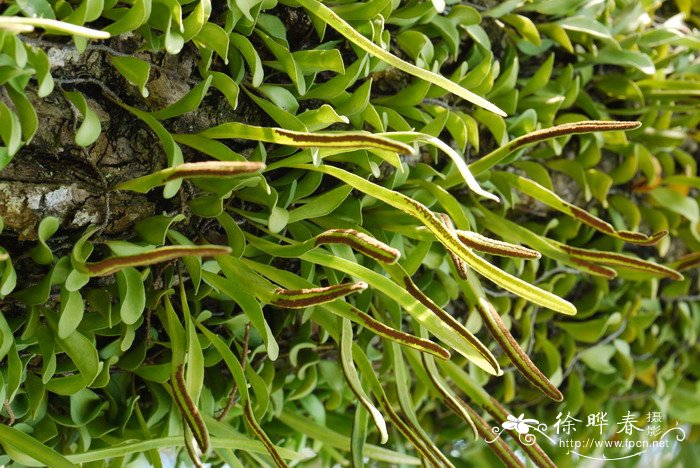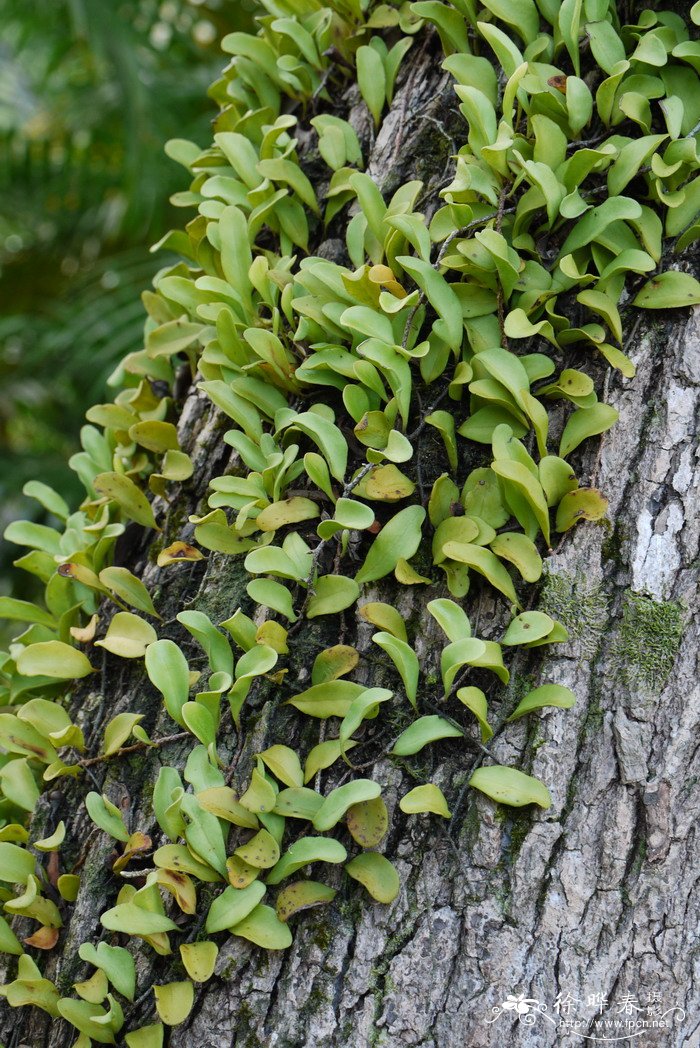贴生石韦Pyrrosia adnascens
中文名(Chinese Name):贴生石韦
学名(Scientific Name):Pyrrosia adnascens (Sw.) Ching
英文名(English Common Name):
别名(Chinese Common Name):
异名(Synonym):Cyclophorus pustulosus Christ Cyclophorus stellatus Copel. Cyclosorus dimorphus Copel. Cyclosorus heterophyllus Desv. Niphobolus spathulifer Bory Cyclophorus bamleri Rosenst. Niphobolus carnosus Blume Niphobolus caudatus Kaulf. Niphobolus chamissonianus C. Presl Niphobolus elongatus Blume Polypodium pachydermum Baker Polypodium pertusum Roxb. ex Hook. Pyrrosia caudata (Kaulf.) Ching Pyrrosia pachyderma (Baker) Ching Pyrrosia stellata (Copel.) Parris
科属(Family & Genus):水龙骨科Polypodiaceae石韦属Pyrrosia
形态特征(Description):植株高约5-12厘米。根状茎细长,攀援附生于树干和岩石上,密生鳞片。鳞片披针形,长渐尖头,边缘具睫毛,淡棕色,着生处深棕色。叶远生,二型,肉质,以关节与根状茎相连;不育叶柄长1-1.5厘米,淡黄色,关节连接处被鳞片,向上被星状毛;叶片小,倒卵状椭圆形,或椭圆形,长2-4厘米,宽8-10毫米,上面疏被星状毛,下面密被星状毛,干后厚革质,黄色;能育叶条状至狭被针形,长8-15厘米,宽5-8毫米,全缘。主脉下面隆起,上面下凹,小脉网状,网眼内有单一内藏小脉。孢子囊群着生于内藏小脉顶端,聚生于能育叶片中部以上,成熟后扩散,无囊群盖,幼时被星状毛覆盖,淡棕色,成熟时汇合,砖红色。
分布(Distribution):产台湾、福建、广东、海南、广西和云南。附生树干或岩石上,海拔100-1300米。亚洲热带其他地区也有分布。全草有清热解毒作用,治腮腺炎、瘰疬
用途(Use):
引自中国植物志英文版:FOC Vol. 2-3 Page 787, 789
Pyrrosia adnascens (Swartz) Ching, Bull. Chin. Bot. Soc. 1: 45. 1935.
贴生石韦 tie sheng shi wei| Polypodiaceae | Pyrrosia
Polypodium adnascens Swartz, Syn. Fil. 25, 222. 1806; Cyclophorus adnascens (Swartz) Desvaux; C. pustulosus Christ; Niphobolus adnascens (Swartz) Kaulfuss; Pyrrosia adnascens f. calcicola K. H. Shing.
Rhizome long creeping, ca. 1 mm thick, in cross section usually with a single, central sclerenchyma strand; phyllopodia 1-2 cm apart, lateral buds alternating with phyllopodia. Scales peltate, 3-5 × ca. 1 mm, base entire to ciliate; acumen light brown, often with a distinct hyaline margin, ciliate. Fronds dimorphic. Sterile fronds: stipe 1-1.5 cm; lamina 1-6 × 0.8-2 cm, base cuneate, apex rounded. Fertile fronds very gradually narrowed at base to a stipe of up to 5 cm; lamina 8-25 × 0.45-0.8 cm, apex obtuse to acute. Hydathodes rarely present, few and indistinct. Indument monomorphic, mostly sparse, whitish to brown; hairs 0.2-1.2 mm with spreading to appressed, boat-shaped to ± acicular rays. Sori distinctly sunken, with a distinct central bundle of stellate paraphyses. Sporangia with stalks 1.5-2 × as long as capsule.
On tree trunks or rocks; sea level to 1300 m. Fujian, Guangdong, Guangxi, Hainan, Taiwan, Yunnan [Cambodia, N India, Nepal, Thailand, Vietnam].
The whole plant is used in traditional Chinese medicine.
Reviewer Ralf Knapp notes that, in Taiwan, this taxon is included in a broadly defined Pyrrosia lanceolata (e.g., Yang & Liu, Man. Taiwan Vasc. Pl. 6: 96. 2002; Knapp, Ferns Fern Allies Taiwan, 338. 2011).
Polypodium pertusum Roxburgh ex Hooker (Exot. Fl. 3: t. 162. 1827) is a Pyrrosia, probably belonging here.


(责任编辑:徐晔春)
学名(Scientific Name):Pyrrosia adnascens (Sw.) Ching
英文名(English Common Name):
别名(Chinese Common Name):
异名(Synonym):Cyclophorus pustulosus Christ Cyclophorus stellatus Copel. Cyclosorus dimorphus Copel. Cyclosorus heterophyllus Desv. Niphobolus spathulifer Bory Cyclophorus bamleri Rosenst. Niphobolus carnosus Blume Niphobolus caudatus Kaulf. Niphobolus chamissonianus C. Presl Niphobolus elongatus Blume Polypodium pachydermum Baker Polypodium pertusum Roxb. ex Hook. Pyrrosia caudata (Kaulf.) Ching Pyrrosia pachyderma (Baker) Ching Pyrrosia stellata (Copel.) Parris
科属(Family & Genus):水龙骨科Polypodiaceae石韦属Pyrrosia
形态特征(Description):植株高约5-12厘米。根状茎细长,攀援附生于树干和岩石上,密生鳞片。鳞片披针形,长渐尖头,边缘具睫毛,淡棕色,着生处深棕色。叶远生,二型,肉质,以关节与根状茎相连;不育叶柄长1-1.5厘米,淡黄色,关节连接处被鳞片,向上被星状毛;叶片小,倒卵状椭圆形,或椭圆形,长2-4厘米,宽8-10毫米,上面疏被星状毛,下面密被星状毛,干后厚革质,黄色;能育叶条状至狭被针形,长8-15厘米,宽5-8毫米,全缘。主脉下面隆起,上面下凹,小脉网状,网眼内有单一内藏小脉。孢子囊群着生于内藏小脉顶端,聚生于能育叶片中部以上,成熟后扩散,无囊群盖,幼时被星状毛覆盖,淡棕色,成熟时汇合,砖红色。
分布(Distribution):产台湾、福建、广东、海南、广西和云南。附生树干或岩石上,海拔100-1300米。亚洲热带其他地区也有分布。全草有清热解毒作用,治腮腺炎、瘰疬
用途(Use):
引自中国植物志英文版:FOC Vol. 2-3 Page 787, 789
Pyrrosia adnascens (Swartz) Ching, Bull. Chin. Bot. Soc. 1: 45. 1935.
贴生石韦 tie sheng shi wei| Polypodiaceae | Pyrrosia
Polypodium adnascens Swartz, Syn. Fil. 25, 222. 1806; Cyclophorus adnascens (Swartz) Desvaux; C. pustulosus Christ; Niphobolus adnascens (Swartz) Kaulfuss; Pyrrosia adnascens f. calcicola K. H. Shing.
Rhizome long creeping, ca. 1 mm thick, in cross section usually with a single, central sclerenchyma strand; phyllopodia 1-2 cm apart, lateral buds alternating with phyllopodia. Scales peltate, 3-5 × ca. 1 mm, base entire to ciliate; acumen light brown, often with a distinct hyaline margin, ciliate. Fronds dimorphic. Sterile fronds: stipe 1-1.5 cm; lamina 1-6 × 0.8-2 cm, base cuneate, apex rounded. Fertile fronds very gradually narrowed at base to a stipe of up to 5 cm; lamina 8-25 × 0.45-0.8 cm, apex obtuse to acute. Hydathodes rarely present, few and indistinct. Indument monomorphic, mostly sparse, whitish to brown; hairs 0.2-1.2 mm with spreading to appressed, boat-shaped to ± acicular rays. Sori distinctly sunken, with a distinct central bundle of stellate paraphyses. Sporangia with stalks 1.5-2 × as long as capsule.
On tree trunks or rocks; sea level to 1300 m. Fujian, Guangdong, Guangxi, Hainan, Taiwan, Yunnan [Cambodia, N India, Nepal, Thailand, Vietnam].
The whole plant is used in traditional Chinese medicine.
Reviewer Ralf Knapp notes that, in Taiwan, this taxon is included in a broadly defined Pyrrosia lanceolata (e.g., Yang & Liu, Man. Taiwan Vasc. Pl. 6: 96. 2002; Knapp, Ferns Fern Allies Taiwan, 338. 2011).
Polypodium pertusum Roxburgh ex Hooker (Exot. Fl. 3: t. 162. 1827) is a Pyrrosia, probably belonging here.
(责任编辑:徐晔春)
踩一下[1]

顶一下[3]